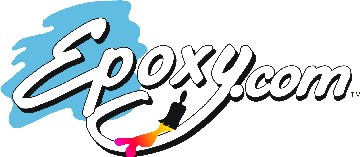Moisture Tolerant
Epoxy Primer
and Base Coat
Epoxy.com Product #100
Can be Used as a Primer Over Concrete as New as 5 Days
Epoxy.com Product #100 Moisture Tolerant Primer and Base Coat consists of a unique water based epoxy technology which allows the contractor to install epoxy resin floor systems and other moisture sensitive floor coverings on new concrete (5 days old) without fear of moisture entrapment. Epoxy.com Product 100 Moisture Tolerant Primer and Base Coat is applied in a two coat application. Epoxy.com Product 100 Moisture Tolerant Primer and Base Coat is the primer/basecoat used in various Epoxy.com Products
Epoxy.com Product #100 Moisture Tolerant Primer and Base Coat is a unique two-component, moisture tolerant, extremely high density, chemically enhanced epoxy based product which reduces the passage of water vapor and moisture through slabs on, above or below grade, thus eliminating delamination and blistering of adhesives, floor coverings, resin floor systems, epoxy terrazzo and coatings.
Epoxy.com Product #100 Moisture Tolerant Primer and Base Coat controls water vapor transmission levels for the installation of most floor covering systems, including VCT, sheet vinyl, carpets, wood, laminates, epoxy resin flooring and epoxy terrazzo.
Advantages
- Vapor and water barrier.
- Can be placed on new concrete in as little as 5 days.
- Water based – low VOC.
- Highly moisture tolerant
- Barrier against radon and other gasses
- Compatible with most flooring systems – conventional, and seamless epoxy flooring systems.
- Does not support the growth of mold.
- Easy to install with little down time.
Considerations
- Substrate must be at least 50° F during installation and curing
- Substrate must be free of dirt, sealers, waxes, and other foreign materials that would interfere with proper bonding.
- Must be installed a minimum of 1/8 for use with moisture sensitive floor coverings.
Application
Surface preparation
Surface preparation is the most critical portion of any successful resinous flooring system application. All substrates must be properly prepared as outlined in Epoxy.com Surface Preparation Procedures. Epoxy.com Technical Support Department is pleased to answer any questions.
Mixing
Epoxy.com Product #100 Moisture Tolerant Primer and Base Coat is a two-component material. Do not alter mixing ratios in any way. Part I and Part II are supplied in the correct mixing ratios. Always mix a complete unit in the proportions supplied.
Stir material for approximately 3-4 minutes to form a homogeneous consistency using a slow speed drill and “Jiffy” blade. Do not entrap excessive air. Scrape all sides and bottom of container to ensure thorough mixing.
Priming
Prime using Epoxy.com Product #100 Moisture Tolerant Primer and Base Coat thinned 10% with one (1) pint of potable water per 1.25 gallon unit for good
penetration. Apply with a squeegee and short nap roller to the properly prepared substrate. Back roll with the short nap roller to achieve a uniform coverage. Allow to cure hard enough for foot traffic, about 3-4 hours at 75 degrees F.Body Coat
Apply one (1) Part of Epoxy.com Product #100 Moisture Tolerant Primer and Base Coat to 4 parts of B. Thoroughly mix with a low speed drill and Jiffy blade until uniform. Mix with low speed drill until uniform and no lumps. Apply with trowel, or squeegee. Allow to self-level and backroll with a looped roller. A 1.25 gallon unit will
cover 30 sq. ft. @ 1/16″.Broadcast surface with broadcast sand to excess (30-50 lbs./100 sq. ft.) with Epoxy.com Product #77 to achieve 1/8 inch. Sweep and vacuum excess or loose sand after hardening (16-24 hours, depending on temperature).
Top Coatings and Overlays
Apply top coatings or resin floor system directly over broadcast surface. Prime surface with appropriate Epoxy.com primer as required. For vinyl flooring and other floor coverings consult with manufacturer of floor covering.
Physical Properties |
|
| Material | 2-component epoxy |
| Density | 12.70 lbs/gallon |
| VOC Content, Mixed | < 1 g/L |
| Solids by Volume | 59% |
| Flash Point: Part A
Part B |
>212°F
170 °F |
| Mixing Ratio | 1:4 by Vol. |
| Pot Life, Approximate | 60 minutes @ 75°F (24°C) |
| Open to Foot Traffic | After 16 hrs. at 73°F (23°C) |
| Curing Temperature | Minimum 50°F |
| Full Cure and Maximum Resistance | 7 days |
| Hardness, Shore D ASTM-D-2240 | 70-75 |
| Compressive Strength ASTM-C- 579 | 6500 psi |
| Flexural Strength ASTM-C-580 | 2100 psi |
| Adhesion To:
-New concrete (5 days) -Moist concrete (28 days) -Dry concrete (28 days) |
110 psi 550 psi 580 psi |
| Temperature Resistance:
a)Continuous: -Dry heat -Humid b)Intermittent: -High pressure water -Dry heat |
140°F (60°C)
113°F (45°C) 185°F (85°C) 149-185°F (65-85°C) |
Maintenance
After completing the application of Epoxy.com Product #100 Moisture Tolerant Primer and Base Coat and the topcoats or floor covering system, the installer should provide the owner with maintenance instructions relevant to the specific topcoats or floor covering. If floors become slippery due to animal fats, oil, grease, or soap film, clean and rinse thoroughly.
More Information
For more information please visit our website at http://www.Epoxy.com, email me at norm@epoxy.com or call Epoxy.com Technical Support Department at 352-533-2167.



 Posted by Norm Lambert
Posted by Norm Lambert  Today we will discuss all the uses of
Today we will discuss all the uses of 